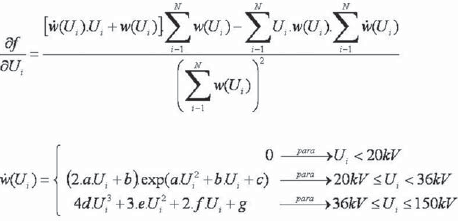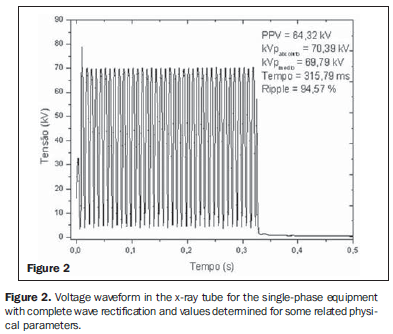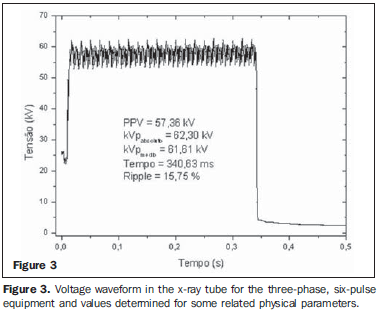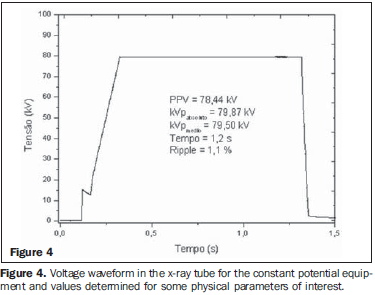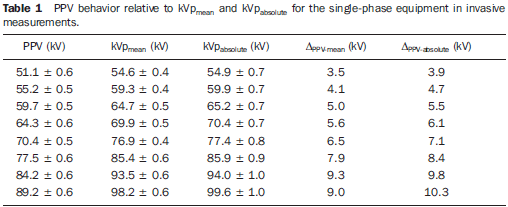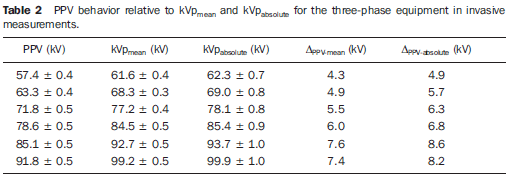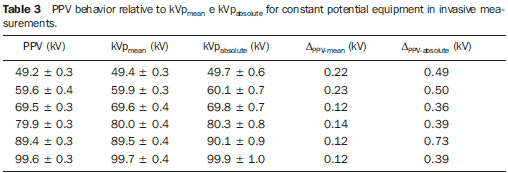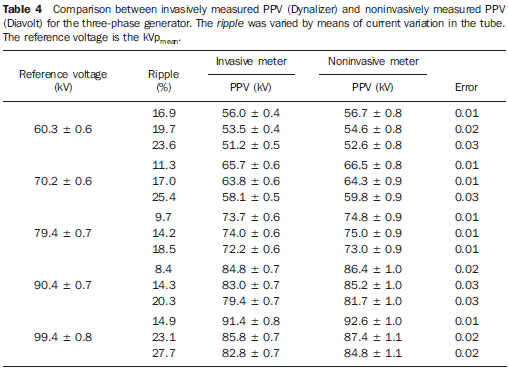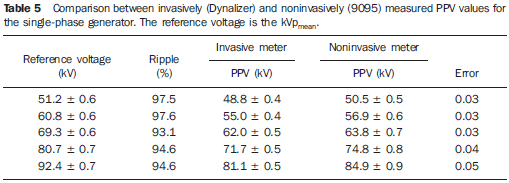Radiologia Brasileira - Publicação Científica Oficial do Colégio Brasileiro de Radiologia
AMB - Associação Médica Brasileira CNA - Comissão Nacional de Acreditação
 Vol. 42 nº 6 - Nov. / Dec. of 2009
Vol. 42 nº 6 - Nov. / Dec. of 2009
|
ORIGINAL ARTICLE
|
|
Measurement of the quantity practical peak voltage in the radiology practice |
|
|
Autho(rs): Ricardo Andrade Terini, Maria da Penha Albuquerque Potiens, Silvio Bruni Herdade, Marco Aurélio Guedes Pereira, João dos Santos Justo Pires, Heber Simões Videira |
|
|
Keywords: Practical peak voltage, X-ray tubes, Voltage divider, Voltage waveform, Peak voltage, kVp meters |
|
|
Abstract:
IPhD in Physics, Titular Professor, Department of Physics - Pontifícia Universidade Católica de São Paulo (PUC-SP), Researcher, Conselho Nacional de Desenvolvimento Científico e Tecnológico (CNPq), Collaborator of Instituto de Eletrotécnica e Energia da Universidade de São Paulo (IEE-USP), São Paulo, SP, Brazil
INTRODUCTION Justification for PPV When a quality control procedure is developed in diagnostic radiology, the determination of the peak voltage (kVp) applied to the x-ray tube plays a fundamental role in the evaluation of the system calibration and performance. It is a well known fact that small variations in kVp values may produce significant increases in patient absorbed doses, due to the approximately squared dependence between air kerma and kVp. The relation between variation in tube voltage and variation of absorbed dose will depend upon the part of the body being irradiated and the used kVp range. Martin et al.(1), for example, have evaluated anteroposterior radiographic views of the abdomen and reported a mean variation of the equivalent dose absorbed by the liver of 3.5% by kVp unit in the range between 60 and 120 kV, 1%/kV between 90 and 100 kV and 13%/ kV between 60 and 70 kV. Another study(2) has demonstrated that a variation in the voltage applied to the tube also produces a significant contribution to the patient absorbed dose due to the scattered beam. Thus, the accuracy of peak voltage measurements and the definition of the measured quantities are of great importance. Several definitions for kVp were created for different purposes(3): kVpabsolute or kVpmaximum (absolute peak voltage: maximum voltage values during exposure), kVpmean (mean peak voltage: average of all maximum values in all voltage cycles during exposure), kVpeffective (effective peak voltage), kVeffective (effective voltage), kVmean (mean voltage), etc., some of them aiming at evaluating the technical performance of the system, while others aimed at evaluating the quality of the produced images. Such definitions are not always clear, and there is no complete consensus amongst users (physicists, engineers, physicians, biomedicine practitioners and technicians) on their meaning and correct practical use. Besides that, the Brazilian Ministry of Health ordinance MS 453(4) of 1998 does not clarify to which definition it refers when the tube voltage is several times mentioned, and when defining values and limits in terms of kVp. Commercial peak voltage meters provide readings of different parameters, which are sometimes indistinctively utilized, for example, to evaluate the tube voltage calibration in clinical systems. The kVp determination may be both electrically made, by means of a calibrated voltage divider coupled with the x-ray tube circuitry, and spectrally(5) made, requiring a high degree of repeatability. Such methods are typically utilized in laboratories of calibration of ionizing radiation measurement instruments such as that of Instituto de Eletrotécnica e Energia, Universidade de São Paulo (IEE-USP), where recent projects(6) were carried out for the development of calibration procedures of invasive systems for kVp measurement by means of x-ray beam spectra. The quantity practical peak voltage (PPV) has been defined in studies developed by researchers of Physikalisch Technische Bundesanstalt (PTB)(7,8) and was introduced to practical use by the I EC 61676(9) standard as an electrical quantity univocally defined and more strongly related to image contrast than other parameters most frequently utilized in the calibration, maintenance and quality control of x-ray equipment, such as kVpmean or kVpabsolute. Currently, PPV is recommended by the International Electrotechnical Commission (IEC)(10) and International Atomic Energy Agency (IAEA)(11), as the standard of voltage applied to radiodiagnosis tubes, in the characterization of x-ray beams to be used for the calibration of dose measurement devices and noninvasive meters of the voltage applied to such tubes. The International Commission on Radiation Units and Measurements (ICRU), in its Report 74(12), includes the PPV when conceptualizing quantities and units involved with dosimetry in x-ray methods for imaging diagnosis. The use of standardized beams allows the intercomparison of results from different laboratories, the reproducibility analysis and greater reliability on the calibration results. The IEE-USP is accredited by National Institute of Metrology, Standardization and Industrial Quality (Inmetro) for calibration tests of kVp meters, and has developed several studies on the measurement of PPV(13-15). Definition of PPV: relationship with CEV The PPV quantity is equivalent, in value, to the so called contrast equivalent voltage (CEV)(7,8), which, on its turn, is defined as the voltage value in which the low level contrast, obtained in an exposure produced by a x-ray tube connected to a generator producing any waveform, be equal to the contrast produced by the same x-ray tube connected to a constant voltage generator, utilizing a phantom with a determined configuration (10 cm of polymethyl methacrylate +1 mm of aluminum, for conventional radiology). Thus, CEV is a quantity obtained from the ratio of measurements performed with ionization chamber of the air kerma values after the polymethyl methacrylate phantom with and without a small 1 mm sheet of aluminum added as a contrast object, for the radiological tube under test and for the standard system of constant potential(16). On the other hand, according to the I EC 61676(9), PPV is electrically determined from the acquisition (preferably performed with an invasive meter, or alternatively with a noninvasive one) of the waveform of the voltage applied to the x-ray tube during the exposure, by the expression (1) below, in which Û is the PPV value, Ui corresponds to the instantaneous values of voltage applied to the tube, acquired in n samples that constitute the waveform; and wi(Ui) corresponds to the values of defined polynomials, for the radiodiagnosis range in the mentioned studies(7-9), that weight each instantaneous value of the applied potential Ui.
- for Ui < 20 kV: where a, b, c, d, e, f, g and h are constants given by: a = -8.646855×10-3; Objectives The present study was aimed at analyzing the PPV behavior in conventional radiology, in invasive measurements (in laboratory) and noninvasive measurements, with clinical and non clinical emitters, with focus on its dependence on the ripple of voltage applied to the X-ray tube. Also, with a view on a greater familiarity with PPV by users of the results from quality control programs, the behavior of PPV was compared with those of other definitions of peak voltage applied in the radiological practice.
MATERIALS AND METHODS Equipment utilized For the measurements performed in the clinical radiodiagnosis range (40-150 kV), the following systems were utilized: a) a Rörix tube, with 124 kV maximum voltage, spinning anode with a tungsten target and 12º angle (gross focus), alternatively connected with two high voltage Siemens generators: a single phase one, model Heliophos 4B, or a three-phase six pulse one; b) an industrial Philips X-ray equipment (Yxlon International X-Ray GmbH) of constant potential (320 kV maximum voltage), with a MCN 323 tube with fixed tungsten anode (22º angle) and beryllium window, and MGC40 controller. The PPV determination requires the acquisition of the voltage waveform. For such purpose, a calibrated invasive voltage divider Radcal model Dynalizer III (Radcal Corp.; Monrovia, USA), with a voltage ratio of 1:20,000, was connected to the circuitry of the single- and three-phase systems. For the constant potential and mammography units, the voltage values were directly acquired from the internal voltage divider, previously calibrated by comparison with the value of the end point of the x-ray spectra produced in each system, measured with a cadmium telluride detector Amptek (Amptek, Inc.; Bedford, USA), according with the method described by Terini et al.(5). For the readings of voltage values, two data acquisition plates models PCI MIO-16E-4 (16 bit, 8 analogical inputs, 250 kpps maximum rate) and NI 5911 (21 bit, 1 analogical input, 1 Mpps maximum rate) (National Instruments Corp.; Austin, USA) and a personal computer were utilized. A software based on LabView (National Instruments Corp; Austin, USA) allowed the acquisition of data from the dividers and the calculation of quantities associated to voltage waveform: kVpabsolute, kVpmean, PPV, exposure time and percentage rate of voltage variation (ripple)(17). The noninvasive measurements of the x-ray tube voltage were performed by using two instruments: a PTW meter, model Diavolt (PTW; Freiburg, Germany) and a Radcal model 9095 meter (Radcal Corp., Monrovia, USA), whose main technical characteristics are: a) PTW, Diavolt - measured quantities: kVpmaximum, kVpmean, PPV, mAs and exposure time; voltage resolution: 0.1 kV; voltage repeatability: ± 1%. b) Radcal, 9095 - measured quantities (obtained from a worksheet): kVpmean, PPV and exposure time; voltage resolution: 0.1 kV; voltage repeatability: ± 1%. Method The measurements were performed by means of the following steps: a) invasive determination of the PPV value and some other x-ray tube applied peak voltage definitions for three types of waveforms: single-phase (two pulses), three-phase (six pulses) and constant potential, for different reference kVpmean values. In this case, the data acquisition rate was maintained at 200,000 pps; b) invasive and noninvasive determination of the PPV value for waveforms of some voltage ripple values (obtained through the variation of the tube current) for different kVmean values with the single-phase and three-phase systems. Figure 1 presents an experimental arrangement scheme utilized in the measurements with the single-phase and three-phase systems. With the other systems, the only difference was the fact that the data acquisition was performed from the x-ray equipment internal voltage divider.
All of the following presented values correspond to averages from three measurements. The PPV uncertainties as well as those of the other quantities were obtained according with the guidelines included in the "Guia para expressão da incerteza de medição" (Guidelines for expression of measurement uncertainty) from Associação Brasileira de Normas Técnicas (ABNT)(18). For B type uncertainties, the information provided by the technical manuals of the voltage dividers and data acquisition plates, as well as the calibration data were considered. Thus, the PPV values uncertainty was calculated by means of the following expression (2), where uc is the combined PPV uncertainty, u(Ui) is the uncertainty of each instantaneous voltage value Ui, and
where:
a, b, c, d, e, f, and g having the same values previously presented in page 390.
RESULTS Figures 2, 3 and 4 show examples of waveforms acquired with the system described in the previous section, for each emitting equipment utilized, as well as the respective determined values, in each case, for PPV and other analyzed quantities.
Tables 1, 2, and 3 show the results of the comparison between PPV and other x-ray tube applied peak voltage definitions for three types of waveforms: single phase (two pulses), three phase (six pulses) and constant potential.
When observing Tables 1 and 2, one notices that the difference (Δ), in kV, between the PPV and the other quantities increases with voltage. On the other hand, Table 3 shows that the difference between PPV and the other quantities remains nearly the same for different voltage values in the constant potential x-ray tube. Table 4 compares invasively and noninvasively (using the PTW meter) obtained PPV values for the three-phase system. Similar results were obtained with the noninvasive Radcal meter.
Table 5 presents the invasively and noninvasively (using the Radcal meter) determined PPV values for the single-phase system. Similar results were obtained with the noninvasive PTW meter.
According to the IEC 61676(9) standard, the results for PPV shall not exceed the relative intrinsic error I, calculated according to the equation (3) and presented on Tables 4 and 5 as "Error".
where: Ûmeas is the value measured by the noninvasive meter; Ûtrue is the conventional true value measured by the reference system (in this case, the invasive system).
DISCUSSION In the present study x-ray emitting units equipped with voltage generators from different generations were utilized, producing several voltage ripple values. This system diversity is still found in many regions throughout Brazil and in some other countries, a different situation from that in Europe, for example, where most of the equipment in use are of the high frequency and constant potential type. As it can be seen on Table 4, the PPV value, invasively measured for three-phase nominal voltage of 100 kV, ranges from 91.4 to 82.8 kV, while the ripple ranges between 15% and 28%. The observed variation in the PPV values corresponds to different contrast levels that would be expected in images obtained with these waveforms, for a given kVpmean (reference voltage). When the results are analyzed, one observes that, except for deviations caused by meter calibration problems, there is a tendency for the intrinsic error to increase as the percentage undulation (ripple) increases. For the single-phase equipment, it was not possible to study the ripple variation for the same reference voltage, on Table 5, however one observes that the difference between the invasively calculated PPV and the noninvasively calculated value increases more significantly than in the previous case, as the reference voltage level also increases. Therefore, as previously pointed out, the presented measurement results indicate the need to correct the PPV values obtained with the noninvasive meter used, in the characterization of clinical systems. The cause for the differences with the invasively obtained values seems to be due to the fact that the waveform detected by the noninvasive meter is not complete, i.e., in the calculation of the tube voltage, only instantaneous values higher than a minimum (for example, 40 kV) are taken into account. This does not affect the determination of peak voltage values, but does interfere on the determination of PPV, which takes into account the whole waveform.
CONCLUSION In Europe, the PPV quantity has been in use over the decade since the advent of the first meters capable of measuring it. In Brazil, the discussion is still in the academic field, still with little impact on the radiological practice. Over the last few years, the acquisition of new noninvasive meter models by companies and Brazilian professionals has increased the demand for clarification in the characterization and differentiation of PPV from other known tube voltage definitions. Today, at least four noninvasive equipment models capable of measuring PPV, besides other quantities, are found in the market. The present study was aimed at evaluating the response from two of these noninvasive meters with respect to different percentage waves. The results demonstrated that both meters were, in many points, outside the limits of intrinsic error recommended by IEC 61676 standard (equation 3), which may lead to evaluation errors, mainly in higher ripple clinical systems. This fact demonstrates the need to develop appropriate meters for the reality of equipments currently in use in Brazil, as well as the need to calibrate the available noninvasive meters, not only for the most common definitions of peak voltage, but also in terms of PPV, for different voltages and voltage waveforms, with higher or lower ripple. At a time when the extension of the PPV concept for a wider range of tensions(19) is under study for other applications, the inclusion of PPV, among other topics, in a coming review of MS 453/98 ordinance (4) would be of great value to consolidate its practical use. In another study, the results of measurements of PPV in mammography will be presented as well as their variation with the data acquisition rate. Acknowledgments The authors wish to thank the Physikalisch Technische Bundesanstalt, for the loan of the noninvasive PTW meter utilized in the present study, and for the invaluable suggestions; the Instituto de Radioproteção e Dosimetria/Comissão Nacional de Energia Nuclear, for the transfer of the data acquisition plate; and the Serviço Técnico de Aplicações Médico-Hospitalares of Instituto de Eletrotécnica e Energia of Universidade de São Paulo and its staff, for the support and possibility of using their infrastructure.
REFERENCES 1. Martin CJ, Sutton DG, Sharp PF. Balancing patient dose and image quality. Appl Radiat Isot. 1999;50:1-19. [ ] 2. Fung KKL, Gilboy WB. The effect of beam tube potential variation on gonad dose to patients during chest radiography investigated using high sensitivity LiF: Mg, Cu, P thermoluminescent dosemeters. Br J Radiol. 2001;74:358-67. [ ] 3. Ranallo FN. The non invasive measurement of X-ray tube potential [thesis]. Madison: University of Wisconsin-Madison; 1993. [ ] 4. Brasil. Ministério da Saúde. Secretaria de Vigilância Sanitária. Diretrizes de proteção radiológica em radiodiagnóstico médico e odontológico. Portaria nº 453/98, de 1/6/1998. Diário Oficial da União, Brasília; 2 de junho de 1998. [ ] 5. Terini RA, Pereira MAG, Künzel R, et al. Comprehensive analysis of the spectrometric determination of voltage applied to X-ray tubes in the radiography and mammography energy ranges using a silicon PIN photodiode. Br J Radiol. 2004; 77:395-404. [ ] 6. Piedade PA. Desenvolvimento de um procedimento metrológico para calibração de medidores invasivos da tensão aplicada a tubos radiológicos através do espectro dos raios X medido com detectores semicondutores. Trabalho de conclusão de curso (graduação em Física). São Paulo: PUC-SP; 2005. [ ] 7. Kramer HM, Selbach HJ, Iles WJ. The practical peak voltage of diagnostic X-ray generators. Br J Radiol. 1998;71:200-9. [ ] 8. Baorong Y, Kramer HM, Selbach HJ, et al. Experimental determination of practical peak voltage. Br J Radiol. 2000;73:641-9. [ ] 9. International Electrotechnical Commission. Medical electrical equipment - Dosimetric instruments used for non-invasive measurement of X-ray tube voltage in diagnostic radiology (IEC 61676:2002). Geneva: International Electrotechnical Commission; 2002. [ ] 10. International Electrotechnical Commission. Medical diagnostic X-ray equipment - Radiation conditions for use in determination of characteristics (IEC 61267:2005). Geneva: International Electrotechnical Commission; 2005. [ ] 11. International Atomic Energy Agency. Dosimetry in diagnostic radiology - an international code of practice. Viena: TRS 457; 2007. [ ] 12. International Commission on Radiation Units and Measurements. Patient dosimetry for X-rays used in medical imaging. ICRU Report 74. Oxford: University Press; 2005. [ ] 13. Pires JSJ, Terini RA, Botttaro M, et al. Dependência do potencial de pico prático (PPV) com o "ripple" da forma de onda de tensão aplicada ao tubo de raios X. In: III Iberian Latin American and Caribbean Congress of Medical Physics and IX Brazilian Congress of Medical Physics; 2004 Set 26-29; Rio de Janeiro, RJ. Proceedings in CD. São Paulo: Associação Brasileira de Física Médica; 2004. [ ] 14. Pires JSJ, Terini RA, Herdade SB. Determinação da incerteza combinada para o cálculo do potencial de pico prático. In: X Congresso Brasileiro de Física Médica; 2005 Mai 26-29; Salvador, BA. Anais em CD. São Paulo: Associação Brasileira de Física Médica; 2005. [ ] 15. Pires JSJ, Terini RA, Potiens MPA, et al. Variation of the practical peak voltage with the sample rate for a mammography waveform generator. In: International Nuclear Atlantic Conference (INAC 2007); 2007 Set 30-Out 5; Santos, SP. Proceedings in CD. Rio de Janeiro: Associação Brasileira de Energia Nuclear; 2007. [ ] 16. Videira HS, Terini RA, Herdade SB, et al. A comparison between the contrast equivalent voltage (CEV) and the practical peak voltage (PPV) for clinical X-ray systems. In: World Congress on Medical Physics and Biomedical Engineering 2006; 2006 Aug 27-Sep 01; Seoul, Korea. Proceedings in CD. Berlim: Springer-Verlag; 2006. [ ] 17. Pires JSJ. Avaliação da grandeza tensão de pico prática em equipamentos clínicos utilizados em radiodiagnóstico [dissertação de mestrado]. São Paulo: IPEN/CNEN-SP; 2007. [ ] 18. Associação Brasileira de Normas Técnicas. Guia para expressão da incerteza de medição. 3ª ed. Rio de Janeiro: Associação Brasileira de Normas Técnicas; 2003. [ ] 19. Kramer HM, Selbach HJ. Extension of the range of definition of the practical peak voltage up to 300 kV. Br J Radiol. 2008;81:693-8. [ ] Received March 9, 2009. * Study developed at Seção Técnica de Desenvolvimento Tecnológico em Saúde - Instituto de Eletrotécnica e Energia da Universidade de São Paulo (IEE-USP), São Paulo, SP, Brazil. Financial support: Conselho Nacional de Desenvolvimento Científico e Tecnológico (CNPq). |
|
Av. Paulista, 37 - 7° andar - Conj. 71 - CEP 01311-902 - São Paulo - SP - Brazil - Phone: (11) 3372-4544 - Fax: (11) 3372-4554
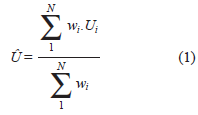

 ;
; 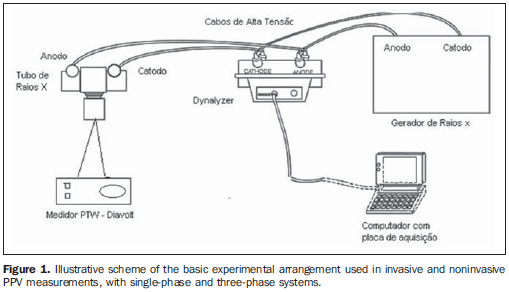
 f/
f/
